THE SCIENCE OF POULTRY LIGHTING
Juliette L. Delabbio, PhD.
Director of Biological Research and Development
Once Innovations Inc.
ABSTRACT:
In poultry farming, artificial lighting is a tool which can, when applied properly, greatly enhance performance and therefore profitability. An artificial lighting system in a barn has three characteristics--color of the light (wavelength), intensity of the light, and the amount of time the lights are on each day (daily photoperiod).
With the development of LED technologies, farmers can now simultaneously vary the color, intensity and photoperiod of the lighting in animal houses and barns. This is important because many scientific studies have demonstrated that simultaneous management of these three components can greatly improve poultry production. Traditionally, the artificial lighting in a barn has been limited to incandescent, fluorescent or high- pressure sodium lamps. These lamps have fixed intensity and fixed color; therefore, once installed the only controllable variable is the length of daily light exposure (photoperiod). With LEDs, two more characteristics of the lighting can be manipulated, thus giving new tools for farmers to increase productivity and improve animal welfare. Indeed, it has been reported that skillful application of LED lighting systems can increase net profit by 20-30% (Rozenboim et al., 2005).
THE USE OF LIGHTING PROGRAMS IN TODAY’S FARMING
In farming, it is important to understand how different animals receive information from the light in their environment because light stimulation is one of the key environmental cues for initiation and synchronization of many physiological processes in an animal’s body (i.e. reproduction). The type of light in its environment also affects an animal’s behavior, such as feeding activity; the animal’s physiological processes, such as rate of growth; as well as overall condition (i.e. stress levels).
Humans receive information about the light in their environment through their eyes only; this is called retinal stimulation. However, other animals receive information about the light in their environment through their eyes AND through other sensors in their bodies. Overall, these structures are called “extra retinal” photoreceptors. Different animals have different extra retinal photoreceptors (Foster & Soni, 1998; Vigh et al., 2002).
This paper concentrates on poultry farming and the application of lighting programs to increase profitability, however it is important to note that the same principals can and are being used quite successfully in agriculture enterprises involving all types of animals.
ANIMALS AND LIGHT PERCEPTION
In the vision of all animals, the information the brain receives about light is dependent on structures in the eye that absorb the light. These structures are called photoreceptors. Different types of photoreceptors absorb different types (wavelengths) of light. Therefore, if a specific photoreceptor is not found in the animal for a certain wavelength of light, the animal will not perceive the light even though it is present in the environment. For instance, humans do not have photoreceptors for ultraviolet light (300 nm wavelength) and therefore cannot perceive it even when it is present in the environment.
On the other hand, chickens do have photoreceptors for UV light and are aware of it and react to it. Thus, it is important when establishing an effective lighting program to understand that it is not the color of light in an animal’s environment as much as the animal’s ability to perceive that color which needs to be considered.
The same consideration must be made when deciding lighting intensity. Not only are the different photoreceptors selectively sensitive to different colors of light (wavelength) but they are also differentially sensitive to light intensity.
The ability to be stimulated by different intensities of light in the environment is not so much dependent on the type of photoreceptor, although this is a factor, but more significantly on the number of these photoreceptors. This makes the difference on the level of light that the animal can perceive. The fact that human and poultry not only have different types of photoreceptors but also different numbers of some photoreceptors is important to remember when establishing intensity of lighting programs for poultry. Although humans and poultry can both see blue color, poultry have more photoreceptors for this color and therefore perceive more light of this color in the environment than a human would (actually 12 times more) (Lewis & Morris, 2000).
Since different animals perceive the same lighting in an environment differently, a farmer cannot use measurements of the human perception of light in an environment to establish appropriate lighting programs for his farm animals. For truly appropriate lighting measurements, a farmer should use select photometers designed to give measurements representing the farm animal’s perception of light in the environment.
Up until now, we have discussed the perception of light in the environment by different animals through the animal’s eyes. Attention must also be given to “extra retinal” light stimulation, a way of perceiving light that humans no longer have but which still remains active and viable in many animals. Poultry, like many other vertebrates, can light in the environment through bodily structures other than their eyes-- these are known as “extra-retinal” photoreceptors (Lewis & Morris, 2000; Menaker & Underwood, 1976).
The pineal gland, which sits on top of the brain in a bird, is one of these extra retinal photoreceptors. Poultry also have deep brain photoreceptors that lie at the base of the brain. Similar to the response in the eyes, extra-retinal light perception stimulates the brain and consequently can trigger physiological responses and affect the animal’s behavior. This type of light stimulation cannot be overlooked when establishing lighting programs for poultry, as it can have pronounced impact on production and therefore profitability. For instance, blue light in a poultry barn reduces stress on the birds (Lewis & Morris, 2000). This response to light can increase the bird immune response (Seon et al., 2014), which in turn can reduce the risk of and treatment costs of infection to certain diseases. Higher survival levels in the flock and lower costs of production support profitability.
RESEARCH UPDATE ON CHICKENS AND LIGHTING PROGRAMS
Researchers have examined the use of artificial lighting in the environment as an effective tool to manipulate certain processes, affect desirable behavior and encourage certain conditions for many decades. Much of this research is limited in application because of the type of lamp used, the incomplete reporting of the lamp characteristics (descriptions of color output and light intensity are often absent) and the use of light meters which report human perception of light in the environment instead of establishing the level of light the bird perceives from its environment.
However, some recent research using LED lighting programs has emerged and is now being utilized by the poultry industry. It must be remembered that LED lighting is a new technology, having developed into widespread commercial applications over the past 10 years. Until then, various florescent, incandescent and metal halide lamps were the only source of artificial lighting for agriculture, and as mentioned earlier, lighting systems using these lamps are severely restricted in their flexibility to vary either light wavelength or intensity in the rearing environment.
THE COLOR OF LIGHT MATTERS
As early as 1987, it was known that the color of light affects bird performance (Pyrzak et al.,1987) but the ability to use this information was limited. Now, with the development of LED technologies and the ability to be more selective in the color of light delivered, research has discovered how useful a tool the color of light can be in enhancing flock performance.
There are substantial benefits to using the proper color of light in a poultry barn. The effects can be long-term, by impacting the onset of first lay, or short- term, by influencing the level of aggressiveness within
the flock. The science behind these findings shows that some of a bird’s deep brain photoreceptors are stimulated into action by only very specific colors of light. The stimulation of these photoreceptors is very important since they signal the production and release of certain hormones; hormones responsible for such actions as sexual development, aggressive behavior and egg production (El Halawani, 2013; Er et al., 2007; Foster & Soni, 1998; Huber-Eicher et al., 2013).
Red light has a significant impact on egg-laying performance and much research has been done on which type of red light is most beneficial. Two recent studies (El Halawani 2009, Huber-Eicher et al, 2013) show that red light (630 wavelength) is the most beneficial to laying hens; this particular color is “superior to any other wavelength in increasing egg production“(El Halawani, 2009).
Blue light improves growth (Lewis & Morris, 2000) and reduces activity (Rodenboog, 2001).
El Halawani in 2013 examined the application of these two light colors at different times during the day in a single LED bulb. His findings showed that a programmed LED light, emitting both red and blue light selectively throughout the day was most beneficial to flock performance.
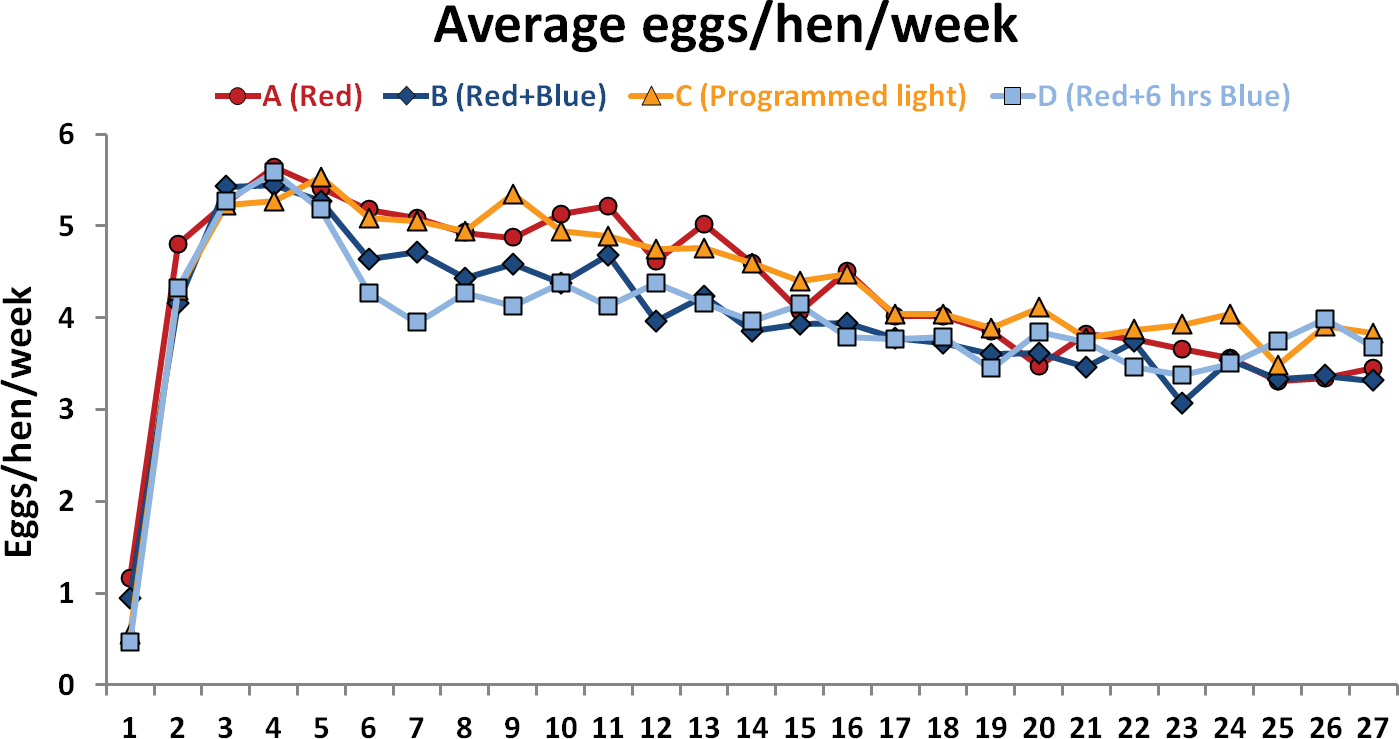
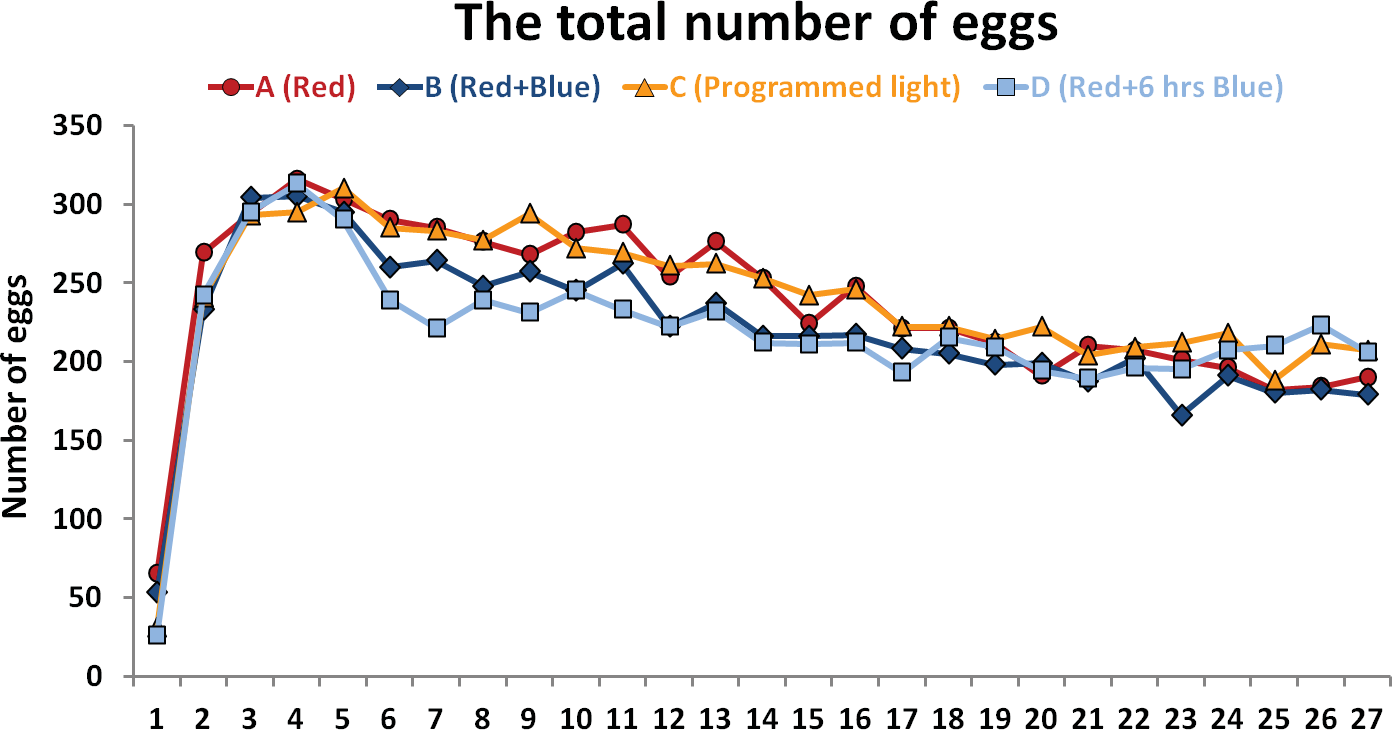
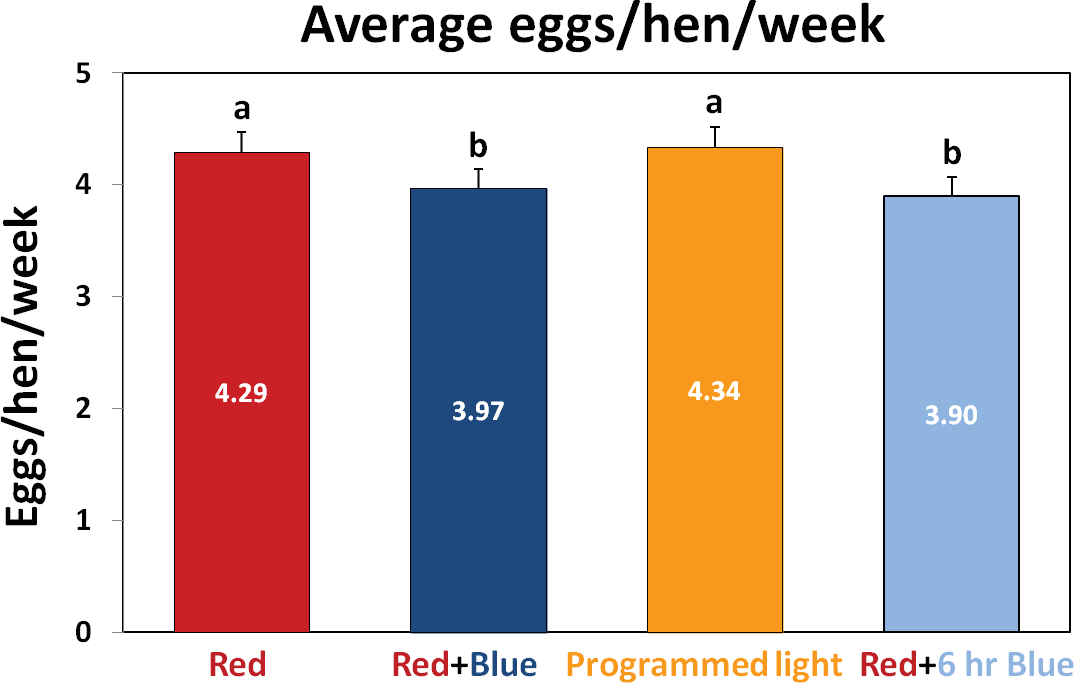
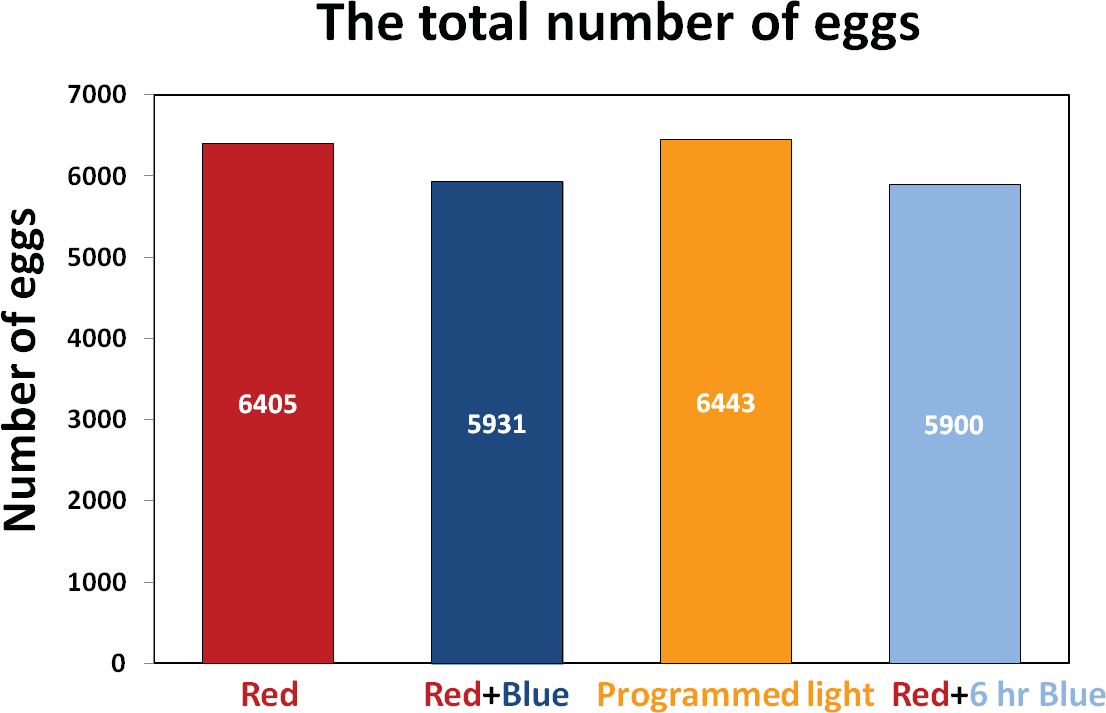
LIGHT INTENSITY IS EQUALLY IMPORTANT
The intensity or brightness of a lighting system (a separate component from color) is equally important in maximizing hen performance (Rozenbolm et al.,1998). Recent work by El Halawani (2009) provided evidence that red LED lights (630nm wavelength lighting) at 30 Lux (or 3 foot candle) enhances egg production. The following bar graph indicates the impact on egg production of the same color of light but at different light intensities.
Most recent work completed by El Halawani (2013) indicates that coupling the best LED lamp color with the best light intensity can have a major impact on egg production. Eggs/hen/week was maximized at 4.34 +0.18 by using the ONCE INNOVATIONS programmed lighting. This programmed lighting showed a statistically significant increase of 38 eggs per hen over a 27-week production period. In a barn holding 10,000 laying hens this amounts to a substantial increase in production.
SUMMARY OF RESEARCH ON THE EFFECT OF LIGHTING PROGRAMS ON POULTRY
The following table summarizes the recent research findings.
TABLE 1: The importance of select colors of light to poultry performance
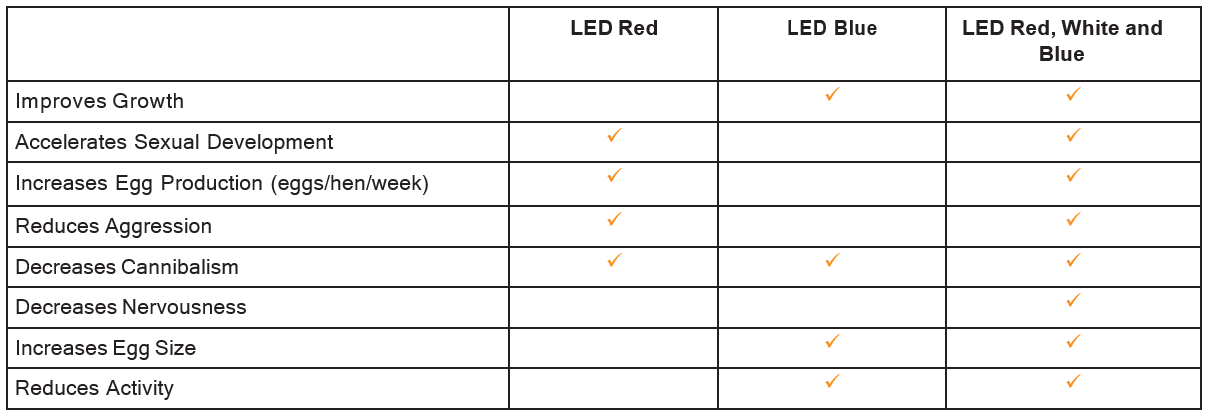
WHAT IS THE ECONOMIC ADVANTAGE TO USING LED LIGHTING PROGRAMS
Up until now we have been discussing the advantages of LED lighting systems in manipulating the biology of the animal under culture, in this case poultry. These advantages however can be translated into real economic benefits to the farmer. The following is an example of recent results of in situ trials of LED lighting programs in poultry barns in the USA.
RECENT (2013) FIELD RESULTS USING VARIABLE LED LIGHTING IN A BROILER BARN IN NORTH CAROLINA

When harvested, the birds under the LED lighting program in this trial were 3 % heavier than the same age birds reared under traditional incandescent lighting. Given that these barns hold over 20,000 birds at a time, it is easy to see the multiplier effect of a 3% gain in weight. The birds also gained more weight but ate less food. Food conversion is derived from a ratio of food consumed to weight gained. Again, a difference of 0.03 in feed conversion may not seem like much when considering a single bird but with the multiplier effect of 20,000 birds in a single barn, this better feed conversion amounts to $10,000 per barn per flock. With the ordinary farmer growing 6 flocks a year for each barn (and 2 to 4 barns on a farm) there are SUBSTANTIAL SAVINGS to be gained.
REFERENCES:
El Halawani, F. 2007. Light spectrum and breeder hen turkeys egg production. Proceedings of the Midwest Poultry Federation Convention, St. Paul, USA.
El Halawani, F. 2009. Light intensity requirement for breeder hen turkeys. Gobbles, 66 (4), 6-7.
El Halawani, F. 2013. Light spectrum requirement for maximizing breeder hen turkey egg production. Gobbles, 70 (4), 6-8.
Er, , Wang, Z., Cao, J. and Y. Chen. 2007. Effect of monochromatic light on the egg quality of laying hens. J. Appl. Poult. Res. 16, 605-612.
Foster, , and B. Soni, 1998. Extraretinal photorecptors and their regulation of temporal physiology. Reviews of Reproduction 3,145-50.
Gongruttananun, 2011. Influence of red light on reproduction performance, eggshell, ultra structure and eye morphology in Thai-native hens. Poultry Science, 90, 2855-2863.
Huber-Eicher, , Suter, A. and P. Spring-Stahli. 2013. Effects of colored light-emitting diode illumination on behavior and performance of laying hens. Poultry Science 92, 869-873.
Lewis, D. and T. R. Morris,.2000. Poultry and coloured light. World’s Poultry Science Journal, 56(3),189-207.
Menaker, M and Underwood. 1976. Extraretinal photoreception in birds. Photophysiology 1976, 23, 299-306.
Pyrzak, , Snapir, G., Goodman, G., and M. Perek, 1987. The effect of light wavelength on the production and quality of eggs of the domestic hen. Theriogennology, 28, 947-960.
Rodenboog, , 2001. Sodium, green, blue, cool or warm-white light? World Poultry, 17 (12), 22-23.
Rozenboim, , Silberman, E. and G. Gvarahu, 1998. New monochromatice light source for laying hens. Poultry Science, 77, 1695-1698.
Ryu, K-S., Hassan, R., Sultana, S. and K. W. Kim. 2014. Effect of different monochromatic LED light colors on the performance, blood properties, bone mineral density, meat quality properties and fatty acid composition of broiler International Poultry Scientific Forum-The International Production & Processing Expo, Atlanta, Jan.27-28, 2014.
Vigh, , Manzano, M.J., Zadora, A., Frnak, C.L., Lukats, A., Rohlich, P., Szel, A. and C. David. 2002. Nonvisual photoreceptors of the deep brain, pineal organs and retina. Histopathol. 17(2), 55-5-590.

